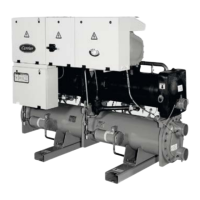26
Evaporator entering water temperature °C 6.8* 21
Evaporator leaving water temperature °C 4** 15
Condenser entering water temperature °C 20*** 45
Condenser leaving water temperature °C 25 50
Outsideambientoperatingtemperature30HXC °C 6 40
* Forapplicationrequiringoperationatlessthan6.8°C,contactCarrierforunit
selectionusingtheCarrierelectroniccatalog.
** For application requiring operation at less than 4°C, the units require the use of
antifreeze.
*** Unitsoperatingatfullloadandbelow20°Ccondenserenteringwater
temperature require the use of a head pressure control with analogue water
controlvalves(seeparagraphonheadpressurecontrol).
Maximumambienttemperature:fortransportandstorageoftheunitsthe
minimumandmaximumallowabletemperaturesare-20°Cand+70°C.Itis
recommendedthatthesetemperaturesarealsoappliedfortransportby
container.
† Foroperationinambienttemperaturesdownto-18°Ctheunitmustbeequipped
withoption28.
1. Evaporatorandcondenser∆T=5K
2. Forstart-upatfullloadwithacondenserwaterenteringtemperaturebelow
20°C,athree-wayvalvemustbeusedtomaintainthecorrectcondensing
temperature
3. Maximumcondenserwaterleavingtemperature50°C(atfullload)
4. Forlowevaporatorleavingtemperatures<+4°Cand>-6°Corderoption5
A Standardunitoperatingatfullload.
B Standardunitoperatingatreducedload.
C Unitsoperatingwithheadpressurecontrolwith
.
For transient operating modes (start-up and part load) the unit can operate
downtoacondenserwatertemperatureof13°C.
Additional operating range for high condensing temperature units and
non-reversibleheatpumps.
Evaporator leaving water temperature, °C
Condenser water entering temperature, °C
The minimum chilled water ow is shown in the table on the next
page. If the ow is less than this, the evaporator ow can be
recirculated, as shown in the diagram. The temperature of the
mixture leaving the evaporator must never be less than 2.8 K
lower than the chilled water entering temperature.
1 Evaporator
2 Recirculation
The maximum chilled water ow is limited by the maximum
permitted pressure drop in the evaporator. It is provided in the table
on the next page. If the ow exceeds the maximum value, two
solutions are possible:
• Select a non-standard evaporator with one water pass less
which will allow a higher maximum water ow rate.
• Bypass the evaporator as shown in the diagram to obtain a
highter temperature difference with a lower evaporator ow
rate.

